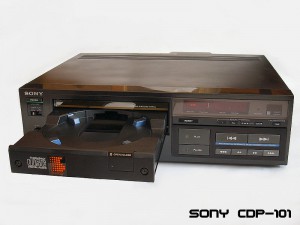 I just read in Physics Today (actually, their Facebook stream, I believe) that the world’s first commercial CD player, the Sony CDP-101 was launched exactly thirty years ago yesterday, on October 1, 1982.
I just read in Physics Today (actually, their Facebook stream, I believe) that the world’s first commercial CD player, the Sony CDP-101 was launched exactly thirty years ago yesterday, on October 1, 1982.
I’ll refrain from making more “how time flies” comments. Still… thirty years already! What was more amusing though was reading a contemporary audiophile review of the new player and the then available (very meager) selection of CDs.
I have my own theory as to why some audiophiles dislike digital audio. Regardless of sampling and bandwidth, digital audio places a definite limit on what is being transmitted. If the source is sampled at 44,100 samples/second, you get 44,100 samples a second… gone are delusions about ultrasonic content subtly altering the experience or similar nonsense. With analog equipment, there are no such definite limits; you can always push things a little further, in tiny, incremental improvements. In other words, analog equipment gives you an illusion of freedom that is lost in the digital world.
I still prefer CDs over the hiss of audio cassettes or the pops and crackles of LPs. There is one piece of audiophile lore, however, that is not nonsense, much to my surprise. Cables. Years ago, after a discussion with a friend, I sat down and calculated the impedance of a typical piece of speaker cable. I don’t remember the exact numbers, but there was a very noticeable frequency dependance (amounting to several dB) in the audible range between 20 Hz and 20 kHz.
Still, it does not change my fundamental view on the subject: if a piece of music is not good enough to listen to on a crappy old transistor radio, no amount of expensive equipment will change it, just like putting lipstick on a pig does not make it cuter. And if the music is good enough to listen to on that old radio, you’ll enjoy it anyway.